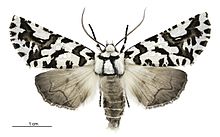| Ipana atronivea | |
|---|---|

| |
| Male specimen | |

| |
| Female specimen | |
| Scientific classification | |
| Domain: | Eukaryota |
| Kingdom: | Animalia |
| Phylum: | Arthropoda |
| Class: | Insecta |
| Order: | Lepidoptera |
| Family: | Geometridae |
| Genus: | Ipana |
| Species: | I. atronivea |
| Binomial name | |
| Ipana atronivea (Walker, 1865) | |
| Synonyms | |
| |
Ipana atronivea, commonly called the North Island lichen moth or North Island zebra moth, is a moth of the family Geometridae. It is endemic to New Zealand and found only in the North Island.
Taxonomy
Ipana atronivea was first described by Frances Walker in 1865 as Detunda atronivea. The male holotype specimen, collected by Captain Parry in Wellington, is held at the Natural History Museum, London. In 2023, the species was moved to the newly reinstated genus Ipana.
Description

The larvae have a lumpy appearance and are brown and brownish-white in colour, growing to approximately 30 mm (1.2 in). In the early stages of their life they look similar to a bird dropping when curled on a leaf. When an adult Ipana atronivea has a wingspan of between 40–45 mm (1.6–1.8 in).
This moth is white with dark brown or black markings. It is very similar in appearance to its close relation the South Island lichen moth, Ipana egregia, but it has fewer dark markings and does not have the dark edges on the forewing. This gives Ipana atronivea a more mottled appearance; it also has a black rectangular mark on the back of the thorax.
Hudson noted that Ipana atronivea "varies considerably in the size and shape of the black markings on the fore-wings, which are often slightly different on the opposite sides, in the same specimen." One authority has claimed that Ipana atronivea is the only one of 180,000 Lepidoptera species with asymmetrical patterning: its wings are not mirror images of each other.
Research has indicated that the forewing colouration of this species is much more likely to protect the moth against predation when the adult insect is at rest on lichen compared to when it is resting on bare tree trunks.
Distribution and habitat
This species is endemic to New Zealand and is found in the North Island. In 1913 it was regarded as being rare in Whanganui region but was noted as being very common about Mount Taranaki and Mount Ruapehu. It has also been found in Wellington, Ōtaki and Napier.
Life stages

The eggs of Ipana atronivea are laid from the end of October. They are oval in shape, slightly roughened on their surface and start out green in colour, turning a light blue shade covered with purple spots after approximately a week and then to a light purple colour just prior to hatching. The eggs are laid singularly and hatch after 11 days. Although the larvae are generally brownish or blackish green in colour they can vary in shade significantly. The pupae inhabit a light coloured cocoon which they form amongst leaves on the surface of the ground. The adults emerge in February and March. Some overwinter as pupae while others transform into adult moths.
Host plant
The host plants of the caterpillars of Ipana atronivea are Araliaceae including Neopanax arboreus and Pseudopanax crassifolius.
References
- ^ "Declana atronivea (Walker, 1865)". www.nzor.org.nz. Landcare Research New Zealand Ltd. Retrieved 6 February 2017.
- ^ Dugdale, J. S.; Emmerson, A. W.; Hoare, R. J. B. (2023). "Declana and Ipana (Insecta: Lepidoptera: Geometridae: Ennominae)". Fauna of New Zealand. 82: 1–120. doi:10.7931/J2/FNZ.82. ISSN 0111-5383. Wikidata Q124100766.
- ^ "North Island Lichen Moth". www.landcareresearch.co.nz. Landcare Research New Zealand Ltd. Retrieved 6 February 2017.
- Walker, Francis (1865). List of the Specimens of Lepidopterous Insects in the Collection of the British Museum Part 31-32. London: Trustees of the British Museum. p. 619. Retrieved 6 February 2017.
- Yu, Dicky Sick Ki. "Declana atronivea (Walker 1865)". Home of Ichneumonoidea. Taxapad. Archived from the original on 7 February 2017. Retrieved 6 February 2017.
- Dugdale , J. S. (23 September 1988). "Lepidoptera - annotated catalogue, and keys to family-group taxa". Fauna of New Zealand. 14. Department of Scientific and Industrial Research: 164. doi:10.7931/J2/FNZ.14. ISSN 0111-5383. Wikidata Q45083134.
- ^ Early, John (2009). Know your New Zealand native insects and spiders. Auckland: New Holland Publishers Ltd. p. 138.
- Shepherd, Lara; Sirvid, Phil (2024-04-01). "The April Fool's Day Files: Natural born liars". Te Papa Blog. Archived from the original on 2024-04-08. Retrieved 2024-05-16.
- Miller, David (1955). Nature in New Zealand Native Insects. Wellington: A. H. & A. W. Reed. p. 15.
- ^ Hudson, G. V. (1898). New Zealand moths and butterflies. London: West, Newman & Co. pp. 95–96. doi:10.5962/bhl.title.7912. Retrieved 6 February 2017.
- Flux, John (Summer 2017). "Moth markings". Forest & Bird (366): 56.
- Cassandra J. Mark; James C. O'Hanlon; Gregory I. Holwell (8 October 2022). "Camouflage in lichen moths: Field predation experiments and avian vision modelling demonstrate the importance of wing pattern elements and background for survival". Journal of Animal Ecology. doi:10.1111/1365-2656.13817. ISSN 0021-8790. PMID 36169598. Wikidata Q114918891.
- ^ Watt, Morris N. (1913). "Descriptions of the Ova of some Lepidoptera of New Zealand". Transactions and Proceedings of the New Zealand Institute. 46: 65–95 – via Biodiversity Heritage Library.
- Spiller, D.; Wise, K. A. J.; Dale, P. S.; Maddison, P. A. (1982). A catalogue (1860–1960) of New Zealand insects and their host plants. Wellington: DSIR Science Information Division. p. 140. ISBN 0477066933. OCLC 10456569.
External links
| Taxon identifiers | |
|---|---|
| Ipana atronivea | |
| Declana atronivea | |